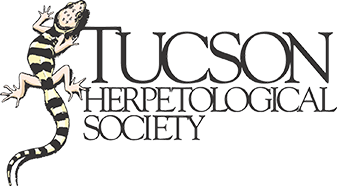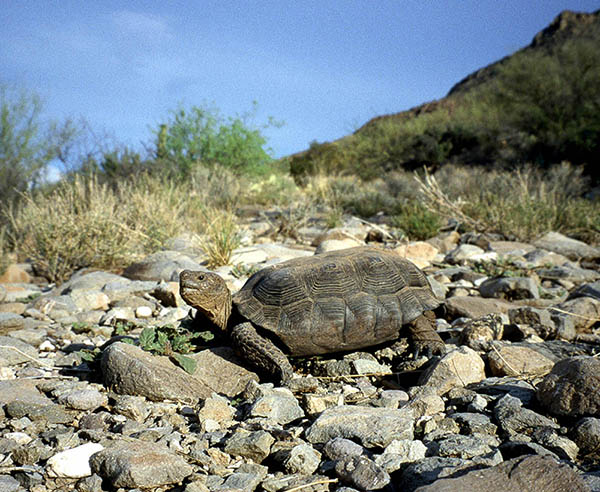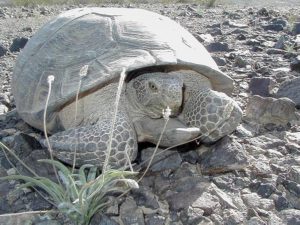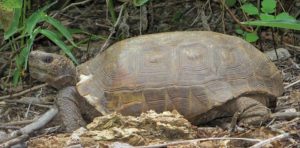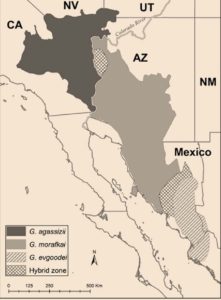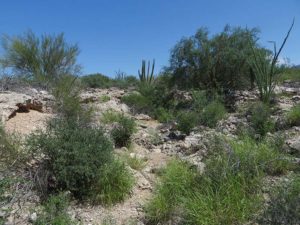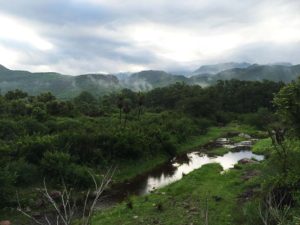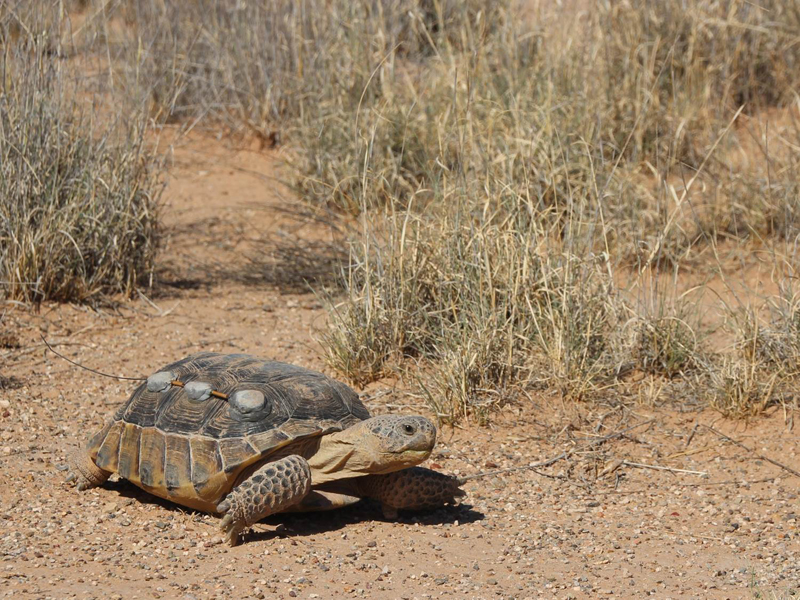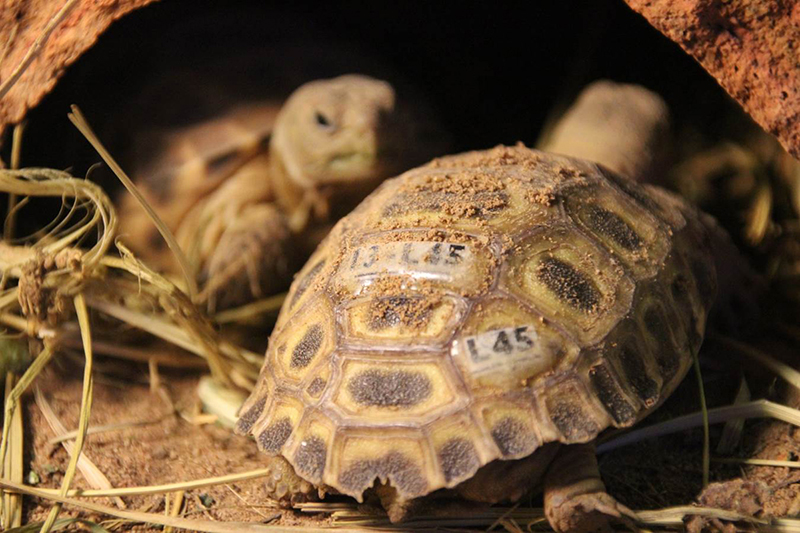Mexico Tortoise Projects
Gopherus morafkai (“Morafka’s” or “Sonoran Desert Tortoise”)
Gopherus agassizii Mojave
(“Agassiz’s” or “Mojave Desert Tortoise”)
Tortoises, of the genus Gopherus, are spectacular both in ecological significance and natural history. Tortoises act as ecosystem engineers, digging multiple burrows in the soil up to eight meters long and two meters deep that they use to thermoregulate through extreme periods of hot and cold. But they aren’t the only ones who benefit from the retreat sites they create, as many other species rely on tortoise burrows for refugia from the desert’s extreme fluctuations in temperature. Rattlesnakes, lizards, owls, frogs, toads, insects, spiders, and rodents have all been documented inhabiting tortoise burrows, making them one the most crucial resources in the desert.
Gopherus evgoodei
(“Goode’s Thornscrub” or “Sinaloan Desert Tortoise”)
There are six species of Gopherus in North America. Three are separate lineages but the desert tortoise complex has recently been divided into three species as explained below. In México the THS works with two projects. One involves two of the three species of desert tortoise and the other supports the Bolson Tortoise of north central México. The other two North American tortoise species, that are not discuss here, are the Texas Tortoise (G berlandieri), which also extends into northeastern México, and the Gopher Tortoise (G polyphemus) of the southeastern United States.
The Desert Tortoise Complex
The term “Desert Tortoise” now refers to a complex of 3 species: G agassizii (“Agassiz’s” or “Mojave Desert Tortoise”) in the United States, primarily west and north of the Colorado River but with a small, isolated population east of the river in and around the Black Mountains near Kingman, AZ; G. morafkai (“Morafka’s” or “Sonoran Desert Tortoise”) in the United States east and south of the Colorado River and south into central Sonora; and G. evgoodei (“Goode’s Thornscrub” or “Sinaloan Desert Tortoise”) in southern Sonora and northern Sinaloa.
Map 1. Distributions of the three desert tortoise species and hybrid zones in the southwestern United Sates and northwestern México. In the northwestern Arizona hybridization area, pure populations of G. agassizii have been found in Mojave desertscrub east of the Colorado River.
G agassizii occurs in arid desertscrub in the Mojave Desert of California, Nevada, Utah, and Arizona west and north of the Colorado River. It is also found in the “Colorado Desert”, which is a local California name for the arid Lower Colorado River Valley and additional Sonoran Desertscrub west of the Colorado River. G. morafkai occurs in Sonoran desertscrub, arid Sonoran Foothills Thornscrub, and sparingly into semi-desert grassland in Arizona and Sonora México. G. evgoodei occurs in relatively mesic Foothills Thornscrub and in drier parts of the Tropical Deciduous Forest (TDF) in Sonora, Sinaloa, and, sparingly, into western Chihuahua, México. Genetic data indicate an ancient origin for the three-species split (ca. 5-6 million years ago).
There are two areas with hybrids (see Map 1). Hybridization occurs where the species overlap in transitional habitats (“ecotones”) as in México or due to a secondary contact of the parent species due to historical changes in the location of the Colorado River as a barrier between populations as in the United States.
Sonoran Desert habitat for G. morafkai
Although approximately 40-45% of the desert tortoise complex’s geographical range is in México, the distribution, ecology, and taxonomic status of the tortoises there are poorly understood. Over the past three decades some work has been done to fill in these knowledge gaps, but much more is needed relative to the conservation status of the species, particularly in the southern portions of their distributions.
Behavioral patterns and ecological challenges for tortoises in these different environments can also vary greatly and must be understood to evaluate the status of populations. In particular, we currently know very little about behavior of tortoises in thornscrub and TDF biomes.The initial phase of this project focused on desert tortoises (G. evgoodei) in the TDF near Alamos, southern Sonora, where its habitat is most different from that of the other two species. A few researchers have conducted focal studies of individual tortoises using radiotelemetry to compare movements, behavior, and feeding of tortoises in the TDF to similar studies in other habitats. Seasonal and other spatial aspects of behavior and ecology have been similarly investigated by following telemetered tortoises at Alamos and have tracked them monthly.
The habitat in Alamos, Sonora México, for G. evgoodei
Researchers have gathered samples for genetic studies on desert tortoise populations at over 30 locations in México, the results of which were analyzed at the University of Arizona, including the population genetic structure of Mexican tortoises, leading to scientific description and naming of G. evgoodei. This and previous research in the United States have resulted in the definition and identification of the three currently known species of desert tortoises. Defining these taxonomic distinctions is necessary for effective conservation of tortoises both inside and outside the U.S. The goal has been to assist in the designation of management units for the entire range of the desert tortoise, including México, so that conservation efforts can be applied with specificity to each area. We can also use genetic data to help to determine the extent to which sampled populations have experienced population declines and to detect hybridization, and therefore which populations are most vulnerable to the combined effects of barriers to gene flow and loss of genetic variability.
Alice Karl, with G. evgoodei
In tandem with collection of genetic samples, researchers also collected health evaluation samples, which revealed little evidence of tortoise disease problems in the wild in México. They also made extensive observations of habitat associations, abundance, and ecology across the range of desert tortoises in México. They found apparently healthy populations in the TDF in northwestern Sonora, and evidence of significant mortality events in both desertscrub and thornscrub in parts of central Sonora, similar to mortality events seen in parts of Arizona.
This project has partnerships with numerous habitat conservation organizations. Nature and Culture International (NCI ‘s) (https://natureandculture.org/) mission is to work with local and indigenous peoples to preserve some of the most biologically diverse systems on earth. NCI focuses in Latin America and has protected over 13 million acres in 6 countries. From Amazon rainforest to Andean cloud forest to coastal and marine areas, NCI is working on the frontlines of ecosystem level conservation. The Reserva Monte Mojino or ReMM (https://natureandculture.org/places/mexico/monte-mojino-reserve/) is their northernmost Reserve protecting some of the last remaining TDF in southern Sonora, México. The Turtle Conservancy (TC) (https://www.turtleconservancy.org/) recognizes that turtles and tortoises are one of the fastest disappearing groups of animals on the planet and is dedicated to protecting them and their habitat. To date, they have protected over 46,000 acres, 45,000 of which are in México. Their work in México has secured lands for both the Sinaloan desert tortoise and the Bolson tortoise (see below). The Desert Tortoise Council (DTC) (https://deserttortoise.org), a nonprofit organized to promote conservation of desert tortoises in the deserts of the southwestern United States and México, as well as individual conservationists, have also supported these reserve acquisitions. The Tucson Herpetological Society (THS) has been an ongoing sponsor of the Mexican Tortoise projects.
In addition to these partnerships, the Mexican Tortoise Project has established working relationships with state and federal government agencies in México, including Comisión de Ecología y Desarrollo Sustentable del Estado de Sonora (CEDES), Comisión Nacional de Áreas Naturales Protegidas (CONANP), and Secretaría de Medio Ambiente y Recursos Naturales (SEMARNAT).
This multinational, cooperative effort has brought together over 75 collaborators from México, Canada, and the United States, including the Tucson Herpetological Society. The project has been operating on a shoestring budget. Its accomplishments have primarily been fueled by participants donating their own time, equipment and expertise. We need your help to keep this project going!
For more information, please contact
Taylor Edwards, taylore@email.arizona.edu
Desert Tortoise References
Edwards T., A.E. Karl, M. Vaughn, P.C. Rosen PC, C.M. Torres, and R.W. Murphy. 2016. The desert tortoise trichotomy: México hosts a third, new sister-species of tortoise in the Gopherus morafkai–G. agassizii group. ZooKeys 562: 131– 158. doi: 10.3897/zookeys.562.6124
Berry, K.H., M.B. Brown, M. Vaughn, T.A. Gowan, M.A. Hasskamp, and M.C. Meléndez Torres. 2015. Mycoplasma agassizii in Morafka’s Desert Tortoise (Gopherus morafkai) in México. Journal of Wildlife Diseases: 51(1):89-100. doi: http://dx.doi.org/10.7589/2014-04-083
Edwards, T., M. Vaughn, P.C. Rosen, C. Meléndez, A.E. Karl, M. Culver, and R.W. Murphy. 2015. Shaping species with ephemeral boundaries: the distribution and genetic structure of desert tortoise (Gopherus morafkai) in the Sonoran Desert region. Journal of Biogeography 43(3):484-497. http://dx.doi.org/10.1111/jbi.12664
Edwards, T., K.H. Berry, R.D. Inman, T.C. Esque, K.E. Nussear, C.A. Jones, and M. Culver. 2015. Testing taxon tenacity of tortoises: evidence for a geographical selection gradient at a secondary contact zone. Ecology and Evolution 5(10): 2095-2114. doi: 10.1002/ece3.1500
Rosen, P.C. (editor). 2014. Conservation Status, Ecology, and Distribution of Desert Tortoises in México: The México Tortoise Project, 2001-2013. Report to United States Fish and Wildlife Service, Arizona Ecological Service Office for Science Support Program Grant GX11BD30EH81500. 161 pages.
Edwards, T., M. Vaughn, C.M. Torres, A.E. Karl, P.C. Rosen, K.H. Berry, and R.W. Murphy. 2013. Biogeographic perspective of speciation among desert tortoises in the genus Gopherus: A preliminary evaluation. In: Gottfried, Gerald J.; Ffolliott, Peter F.; Gebow, Brooke S.; Eskew, Lane G.; Collins, Loa C. Merging science and management in a rapidly changing world: Biodiversity and management of the Madrean Archipelago III and 7th Conference on Research and Resource Management in the Southwestern Deserts; 2012 May 1-5; Tucson, AZ. Proceedings. RMRS-P-67. Fort Collins, CO: US Department of Agriculture, Forest Service, Rocky Mountain Research Station. p. 243-247. (Vol. 67, pp. 243-247).
Murphy, R.W., K.H. Berry, T. Edwards, A.E. Leviton, A. Lathrop, and J.D. Riedle. 2011. The dazed and confused identity of Agassiz’s Land Tortoise, Gopherus agassizii, the description of a new species, and its consequences for conservation. ZooKeys 113: 39-71
Van Devender, T.R. (editor). 2002. The Sonoran Desert Tortoise Natural History, Biology, and Conservation. University of Arizona Press and the Arizona-Sonora Desert Museum Press, Tucson.
The Bolson Tortoise
Bolson Tortoise (G flavomarginatus)
THS is involved in projects with another tortoise from northern México, the Bolson Tortoise, G flavomarginatus, which is the largest of the six North American tortoise species. Occurring in north-central México in an area of the Chihuahuan Desert known as the Bolsón de Mapimí, in the states of Chihuahua, Coahuila and Durango, the Bolson tortoise has the smallest geographic range of all six species.
México: Bolson Tortoise Ecosystem Preserve
The Chihuahuan Desert is composed mostly of arid grasslands and hosts over 3,500 plant species, one-third of which occur nowhere else on the planet. Unfortunately, due to grazing cattle, mining, and unsustainable agriculture, less than 4% remains intact today. These threats imperil the region’s biodiversity and endanger the Bolson Tortoise. The current low estimates of remaining wild tortoises have spurred conservation organizations into action. The approach is two-pronged: habitat conservation and captive breeding.
In 2016, with help from grants from the Leonardo DiCaprio Foundation and Global Wildlife Conservation, the Turtle Conservancy (TC) purchased over 43,000 acres of Chihuahuan Desert and prime Bolson Tortoise habitat in México’s Bolsón de Mapimí, and created the Bolson Tortoise Ecosystem Preserve. TC established a Civil Association in México called HABIO, A.C. to enable the local ownership and management of the Preserve.
United States: Turner Endangered Species Fund (TESF) Bolson Tortoise Project
The TC and Turner Endangered Species Fund (TESF) are collaborating on a trans-national effort to protect this tortoise from extinction, which will include reintroducing the species in key locations of its former range in the United States.
In the United States, the TESF is working on research and management of an assurance colony located in New Mexico. The goal of the assurance colony is to eventually re-establish populations in the wild from animals hatched under human care. HABIO and TC are supporting conservation partners for this work.
In 2006, with an eye toward establishing free-living Bolson tortoise populations in the northernmost part of their pre-historic range in New Mexico, TESF accepted a group of 26 Bolson tortoises already living in the United States at the Appleton Ranch in Arizona as breeding stock to generate new Bolson tortoises for recolonization. Since then, TESF and its partners have established a robust breeding program that has produced over 800 new tortoises, including a handful of tortoises that are beginning to approach breeding age (which appears to be around 15-20 years). The tortoises currently live on two of Ted Turner’s ranches in southern New Mexico. Researchers monitor egg production in the spring, collect and incubate eggs, and welcome hatchlings in the fall. Young tortoises are moved to protected headstart pens where they live until they are large enough to withstand most predator attacks. This can take between 3 and 7 years, depending on the individual animal. Tortoises are then moved to much larger holding pens where they live as semi-wild animals that forage on their own and are not protected from predators. TESF is currently finalizing plans to release these tortoises on protected private lands outside of enclosures. TESF’s partners include the Living Desert Zoo and Gardens State Park, the El Paso Zoo, the San Antonio Zoo, and the Turtle Conservancy’s Behler Chelonian Center in Ojai CA, as well as a number of private individuals who donate their time and expertise.
Bolson hatchlings
The Bolson tortoise provides the opportunity to “rewild” the Chihuahuan Desert of the United States with an extant, but locally extirpated species with the goal to not only help to recover the species from the risk of extinction, but also contribute to restoration of the Chihuahuan Desert via reintroduction of a native, burrowing herbivore. This successful breeding program, managed by biologists Chris Wiese and Scott Hillard, has hatched over 400 juvenile tortoises since 2006, with additional breeding individuals at the Living Desert Zoo and Gardens State Park near Carlsbad, New Mexico. Recently, an additional assurance colony was established at the Turtle Conservancy’s Behler Chelonian Center in Ojai, CA. Through genotyping unknown individuals, the program seeks to identify additional, pure-breed individuals that are eligible for introduction into the breeding population.
A Look to the Future
The TC, HABIO, TESF, and partners are only just beginning on the long road to recovery of the Chihuahuan Desert and its keystone species, the Bolson Tortoise. The TC hopes to continue building on the Mexican Bolson Tortoise Ecosystem Preserve through the purchase of additional, adjacent land parcels for conservation, as opportunities and funding arise. The TC plans to recruit a local property manager for the Preserve who will oversee operations on site, including inspecting and repairing perimeter fences, removing stray cattle, maintaining roads and infrastructure, and supporting research activities.
This project will be incorporating more technology into our research methodologies and we have purchased a fixed-wing survey drone that can be used to collect high-resolution aerial photos of the Preserve. Hopefully we will be able to use those photos to locate tortoise burrows, creating a more effective tortoise survey methodology, especially in the difficult-to-access reaches of the Preserve.
Funding and in-kind support to date have come from the Andrew Sabin Family Foundation, Desert Tortoise Council, Global Wildlife Conservation, Leonardo DiCaprio Foundation, Rainforest Trust, Sundance Biology, Tucson Herpetological Society, and Turtle Conservation Fund.
TESF: http://tesf.org/project/bolson-tortoise-recovery/
For more information please contact:
Mercy Vaughn, manydogs10@aol.com
OR Taylor Edwards, taylore@email.arizona.edu
Bolson Tortoise References
Edwards, T., E.C. Cox, V. Buzzard, C. Wiese, L.S. Hillard, and R.W. Murphy. 2014. Genetic assessments and parentage analysis of captive Bolson tortoises (Gopherus flavomarginatus) inform their “rewilding” in New Mexico. PLoS ONE 9(7): e102787. doi:10.1371/journal.pone.0102787
Truett, J., and M. Phillips. 2009. Beyond historic baselines: Restoring bolson tortoises to Pleistocene Range. Ecological Restoration 27: 144–151.
Help Us Help the Mexican Tortoises
THS is proud to support these efforts in the research and conservation of western North American tortoises. We need your support now more than ever to help keep the Desert Tortoises and the Bolson Tortoise of México and their habitats on the road to recovery!
Please visit our Donate page to make your generous gift to protecting our magnificent tortoises.
Another view of Gopherus evgoodei
